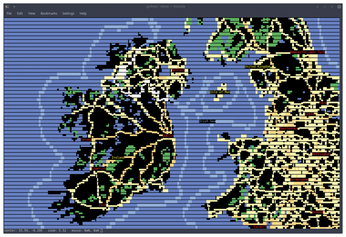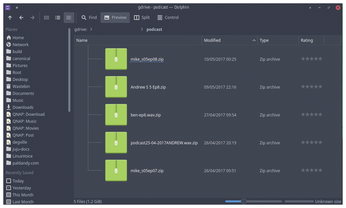Graham tears himself away from updating Arch Linux to search for the best new free software.
mapscii
It always feels a bit of a cheat covering something written with Node.js, because the typical Node.js application often feels like a web application, or even a website. That's because Node.js helps you run things locally written in JavaScript that would typically run on a server on the web. But JavaScript itself has become so popular, perhaps akin to being the BASIC of the web, that using JavaScript with a run-time environment like Node.js is no different to a run-time environment for many other languages, and you get the ability to run your application both offline and online almost for free. How's that for convergence!
This is exactly what's happened with mapscii. It's a brilliant little map tool you can run on the command line via Node.js, and because it's written in JavaScript, you can also do something crazy – connect to an instance of mapscii running on the developer's own telnet server. Yes, telnet. It's a little like something from the War Games movie, except the world view zooms into a street view, thanks to OpenStreetMap. It's remarkably quick and responsive, and going from an Earth-sized scale down to street level takes just seconds. Cursor keys with A and Z to zoom are used to control the map, but you can also use the mouse. The mouse wheel can even be used to zoom, and click-dragging the tiles on the background lets you move around the map just as you would a map in a browser. Even if that sounds like a gimmick when you have your ordinary web browser open, mapscii has another trick: Pressing B will remap the output to the braille unicode font, and you can run the whole thing offline or run your own server and access it from your own devices. Perfect for fast low-bandwidth private navigation.
Project Website
https://github.com/rastapasta/mapscii

File sharing
Google Drive for Plasma
Although many of us have moved away from relying on public cloud storage for all our files, switching to alternatives like Nextcloud, few of us have given up the habit completely. This is because services like Dropbox and Google Drive are genuinely useful. They allow you to share large files, collaborate on document editing, and easily search through the content of files and your editing history. Used with careful consideration of your own privacy, as with cloud-based email, cloud file storage is a useful addition in the connected world. And yet, in the case of Google Drive, a native Linux client has never been forthcoming.
As a KDE user, this makes Google Drive slightly more inconvenient, especially when trying to avoid opening a web browser. And, access to Google Drive's files through a web browser is never ideal. It promotes the idea that you never have to manage your files, never have to delete them. A native-Linux client has always been badly needed. Fortunately, there's now Google Drive integration with KDE's Plasma. It's so well implemented that there's very little to see and not very much to write about. It works as a KIO slave, which means when you use the URL gdrive:// in any KDE application, your Google Drive will be accessed as the destination. The first time you do this, you'll even be stepped through the authentication process, although it can be accomplished from the system-wide accounts page, too, which is also where you can disable the facility. With authentication added, you'll see your Google Drive files just as you would your local files, and they can be opened and saved in the same way. Unfortunately, this doesn't work offline, but it does make copying online files to your local storage trivially easy.
Project Website
https://eang.it/google-drive-integration-in-plasma/

Buy Linux Magazine
Subscribe to our Linux Newsletters
Find Linux and Open Source Jobs
Subscribe to our ADMIN Newsletters
Support Our Work
Linux Magazine content is made possible with support from readers like you. Please consider contributing when you’ve found an article to be beneficial.

News
-
XZ Gets the All-Clear
The back door xz vulnerability has been officially reverted for Fedora 40 and versions 38 and 39 were never affected.
-
Canonical Collaborates with Qualcomm on New Venture
This new joint effort is geared toward bringing Ubuntu and Ubuntu Core to Qualcomm-powered devices.
-
Kodi 21.0 Open-Source Entertainment Hub Released
After a year of development, the award-winning Kodi cross-platform, media center software is now available with many new additions and improvements.
-
Linux Usage Increases in Two Key Areas
If market share is your thing, you'll be happy to know that Linux is on the rise in two areas that, if they keep climbing, could have serious meaning for Linux's future.
-
Vulnerability Discovered in xz Libraries
An urgent alert for Fedora 40 has been posted and users should pay attention.
-
Canonical Bumps LTS Support to 12 years
If you're worried that your Ubuntu LTS release won't be supported long enough to last, Canonical has a surprise for you in the form of 12 years of security coverage.
-
Fedora 40 Beta Released Soon
With the official release of Fedora 40 coming in April, it's almost time to download the beta and see what's new.
-
New Pentesting Distribution to Compete with Kali Linux
SnoopGod is now available for your testing needs
-
Juno Computers Launches Another Linux Laptop
If you're looking for a powerhouse laptop that runs Ubuntu, the Juno Computers Neptune 17 v6 should be on your radar.
-
ZorinOS 17.1 Released, Includes Improved Windows App Support
If you need or desire to run Windows applications on Linux, there's one distribution intent on making that easier for you and its new release further improves that feature.

